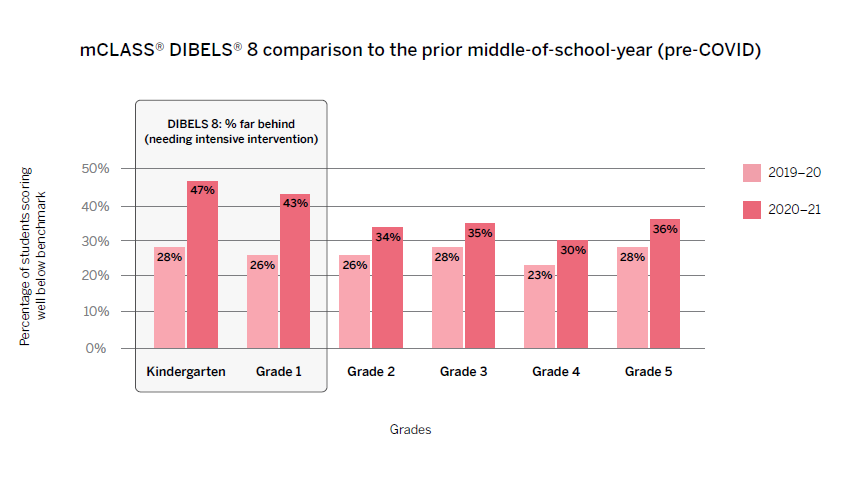Pandemic Literacy Skills
![]() Amplify (an educational testing and curriculum provider) just released a study involving 1.2 million elementary students across the United States on the student’s early literacy skills and the effects of the pandemic shutdowns. The results show the troubling effects our young children are experiencing and what this could mean to these children now and in the future. The learning losses are staggering.
Amplify (an educational testing and curriculum provider) just released a study involving 1.2 million elementary students across the United States on the student’s early literacy skills and the effects of the pandemic shutdowns. The results show the troubling effects our young children are experiencing and what this could mean to these children now and in the future. The learning losses are staggering.
he opportunities to learn that students have lost due to COVID may have life-long consequences if they are not provided with additional instructional support. Several research studies show that absent such additional support, there is nearly a 90 percent chance that a poor reader in Grade 1 will remain a poor reader.
How many children are now behind in Literacy?
As you can see in the graph below the percentage of students who are far behind (i.e. likely to fail benchmarks) at mid-year (20-21) greatly increased (as compared to last year) in all grades, with the biggest learning losses evident in Grades K and 1. Well over 40% of Kinder and 1st graders are scoring well below benchmarks in literacy (i.e. reading and writing). Furthermore, a third of all students in grades 2-5 are at-risk as well! These are very troubling statistics
%
Chance a Poor Reader in Grade 1 Will Remain Poor Reader
Last year, 28% of Grade K students were “well below benchmark” (the lowest category) in early literacy skills. This year, it was 47%. That is a 68% increase in the percentage of Grade K students at greatest risk for not learning to read.
Last year, 26% of Grade 1 students were “well below benchmark” (the lowest category) in early literacy skills. This year, it was 43%. Similar to Grade K, that is a 65% increase in the percentage of Grade 1 students at greatest risk for not learning to read.
These staggering numbers are placing a huge resource burden that our schools are not equipped to handle. Our teachers and administrators are already understaffed and underfunded. For example, a school that needed to offer intensive intervention to 100 Grade K and 100 Grade 1 students in the spring of 2020 is faced with making up for the lost instruction for 168 students (Grade K) and 165 students (Grade 1) in the spring of 2021.Even small increases in the percentage of students well below benchmark—for example, the additional 7–8% in Grades 2 to 5—can overtax school resources.
These lags in skills MUST be addressed and parents are going to need to find their children additional resources and support to help their children overcome this gap. As mentioned earlier, several research studies show that without additional remedial support, there is nearly a 90 percent chance that a poor reader in Grade 1 will remain a poor reader for the foreseeable future.
Insights
Susan Lambert, the Chief Academic Officer of elementary humanities at Amplify, had this to say about the latest data about learning loss across the country:
“With nationwide disruptions continuing, school districts should think about these challenges and make system-wide decisions informed by their data for the spring, summer school, and next school year. The bottom line is that classrooms will need to dedicate more time to reading instruction in the early grades.
Most students will need a double dose of strong core foundational skills instruction (grade-level instruction as well as the instruction they missed), and some students will need additional intervention. We can overcome this lost instruction, but it will take a deep commitment and changes to scheduling and staffing to help all our kids catch up and become the strong readers they can all be.”
Parents – what should you do?
As parents, we need to make sure our children have the best opportunity we can provide. In these unprecedented times it’s vital that we don’t let the circumstances dictate our children’s future:
- Make reading and writing something you do EACH day with your child
- 15 minutes of extra reading outside of school and homework each day
- Make the environment fun and challenging for your child, but don’t force them to read something too far above their level.
- Challenge yourself to find challenging material for your child’s interests.
- Read multiple types of text, primarily books, but also magazines, newspapers, short stories, etc.
- If you need additional help, get it. Don’t let your child become a statistic!
- Let me know if there is anything I or The Reading Ranch can help you with!Thanks and have a great week!

